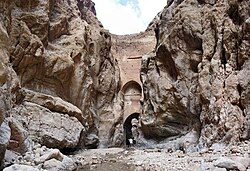Dam
A dam is a large wall or barrier that blocks or stops the flow of water, forming a reservoir or a lake.[1] Most dams have a section called a spillway or weir over which, or through which, water flows, either sometimes or always. Dams generally serve the primary purpose of retaining water. The tallest dam in the world is the 300 meter high Nurek Dam in Tajikistan. Fish ladders are usually added to dams to allow fish to cross over.[2]
History
Some of the first dams were built in Mesopotamia up to 7,000 years ago. Modern dams are built with arched walls of steel rod-reinforced concrete. The arched wall is a very strong shape which helps the wall to withstand the huge weight of the water.
Reasons for building dams
There are a number of reasons that people build dams. Some countries build dams to control the flow of water in the downstream river systems, and prevent flooding. Other countries build dams to generate electricity using hydroelectric turbine generators. Other countries use dams to store water for use in irrigation (for farming) or drinking by people.
Dam Media
The Edersee Dam in Hesse, Germany
The Dujiangyan irrigation system was initially constructed during the Qin dynasty, around 256 BC.
The Roman dam at Cornalvo in Spain has been in use for almost two millennia.
Remains of the Band-e Kaisar dam, built by the Romans in the 3rd century AD
An engraving of the Rideau Canal locks at Bytown
The Hoover Dam by Ansel Adams, 1942
Gordon Dam, Tasmania, is an arch dam.
Daniel-Johnson Dam, Quebec, is a multiple-arch buttress dam.
Dam in Europe at Autumn as viewed from FPV drone.
Notes
| Wikimedia Commons has media related to Lua error in Module:Commons_link at line 62: attempt to index field 'wikibase' (a nil value).. |
- ↑ The American Heritage Dictionary of the English Language, Fourth Edition
- ↑ Doeden, Matt. "Finding Out about Hydropower". wilkinson.marmot.org. Retrieved 2025-04-03.












